- Table of Contents
- Related Documents
-
| Title | Size | Download |
|---|---|---|
| 02-Quick Start | 235.47 KB |
Quick Start configuration examples
Simple text authentication configuration example
WEP (Open-System) encryption configuration example
The Quick Start wizard leads you through basic configuration procedures to quickly make your device available for use.
The interface types and output information vary by device model and radio type.
Quick Start wizard home page
From the navigation tree, select Quick Start to enter the home page of the Quick Start wizard.
Figure 1 Home page of the Quick Start wizard
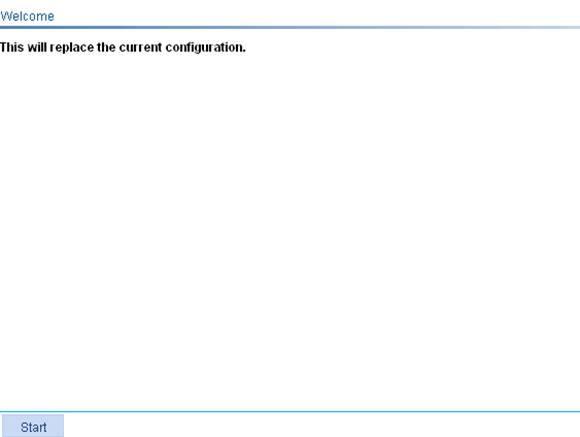
Basic configuration
1. On the home page of the Quick Start wizard, click start.
The basic configuration page appears.
Figure 2 Basic configuration page
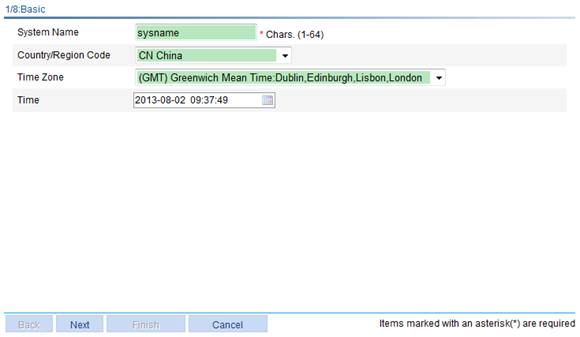
2. Configure the parameters as described in Table 1.
|
Item |
Description |
|
System Name |
Specify the name of the current device. By default, the system name of the device is the device model. |
|
Country/Region Code |
Select the code of the country/region where you are. This field defines the radio frequency characteristics such as the power and the total number of channels for frame transmission. Before configuring the device, you must configure the country/region code correctly. If the Country/Region Code field is grayed out, you cannot modify it. |
|
Time Zone |
Select a time zone for the system. |
|
Time |
Specify the current time and date. |
Admin configuration
1. On the basic configuration page, click Next.
The Admin Configuration page appears.
Figure 3 Admin Configuration page
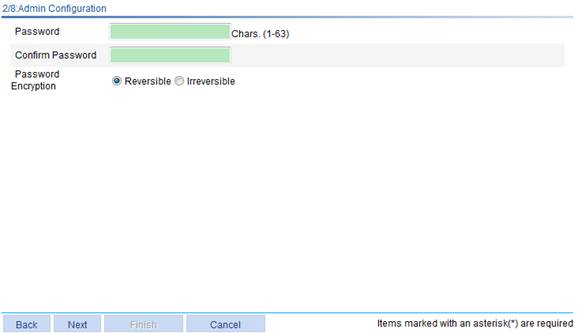
2. Configure the parameters as described in 2.
Table 2 Configuration items
|
Item |
Description |
|
Password |
Specify the password for user Admin to use to log into the device, in cipher text. |
|
Confirm Password |
Enter the password again to confirm the password. |
|
Password Encryption |
Select the attribute for the password encryption method: · Reversible. · Irreversible. |
IP configuration
1. On the Admin Configuration page, click Next.
The IP configuration page appears.
Figure 4 IP configuration page
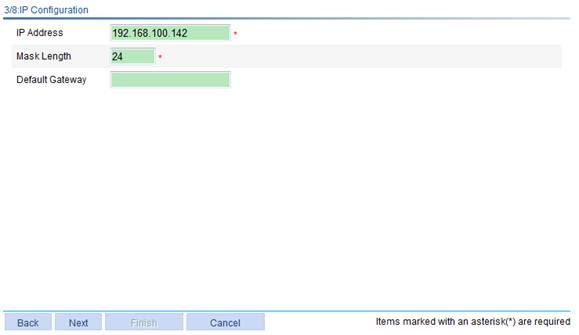
2. Configure the parameters as described in 2.
Table 3 Configuration items
|
Item |
Description |
|
IP Address |
Specify the IP address of VLAN-interface 1. This IP address is used for logging into the device. The default IP address is 192.168.0.50. |
|
Mask |
Specify the IP address mask of VLAN-interface 1. By default, the mask is 24-bit long. |
|
Default Gateway |
Specify the IP address of the default gateway that connects the device to the network. By default, the IP address of the default gateway is not specified. |
Wireless configuration
1. On the IP configuration page, click Next.
The wireless configuration page appears.
Figure 5 Wireless configuration page

2. Configure the parameters as described in 2.
Table 4 Configuration items
|
Item |
Description |
|
Primary Service Authentication type |
Select the authentication type for the wireless service: · None—Performs no authentication. · User authentication (802.1X)—Performs 802.1X authentication. The default authentication type is None. In that case, skip the 5/8: Radius Configuration step. |
|
Wireless Service |
Specify the Service Set Identifier (SSID). |
|
Encrypt |
Select this box to go to the 6/8: Encryption Configuration step. By default, no encryption is performed. If you do not select this option, the 6/8: Encryption Configuration step is skipped. |
RADIUS configuration
1. On the wireless configuration page, select User authentication (802.1X) for the Primary Service Authentication type field.
2. Click Next.
The RADIUS configuration page appears.
Figure 6 RADIUS configuration page
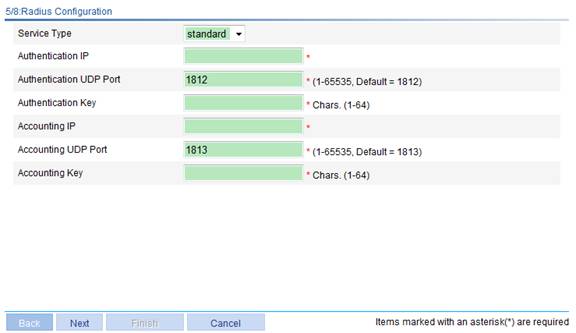
3. Configure the parameters as described in 3.
Table 5 Configuration items
|
Item |
Description |
|
Service Type |
Select the type of the RADIUS server. Two types are available: · extended—Specifies extended RADIUS server, which is usually a CAMS/IMC server. In this case, the RADIUS client (access device) and the RADIUS server exchange packets based on the specifications and packet format definitions of a private RADIUS protocol. · standard—Specifies the standard RADIUS server. In this case, the RADIUS client (access device) and the RADIUS server exchange packets based on the specifications and packet format definitions of the standard RADIUS protocols (RFC 2138, RFC 2139, and the updates). |
|
Authentication IP |
Enter the IP address of the RADIUS authentication server. |
|
Authentication UDP Port |
Enter the port number of the RADIUS authentication server. |
|
Authentication Key |
Enter the shared key of the RADIUS authentication server. |
|
Accounting IP |
Enter the IP address of the RADIUS accounting server. |
|
Accounting UDP Port |
Enter the port number of the RADIUS accounting server. |
|
Accounting Key |
Enter the shared key of the RADIUS accounting server. |
Encryption configuration
1. Select the Encrypt box on the wireless configuration page.
The encryption configuration page appears.
Figure 7 Encryption configuration page
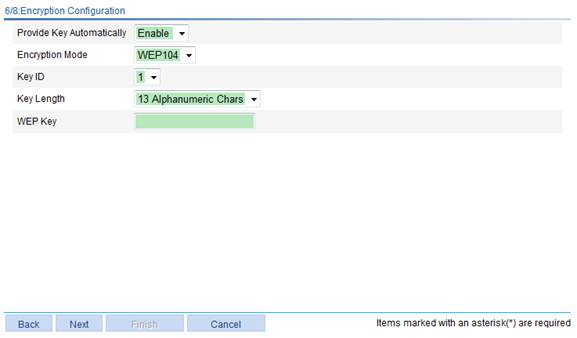
2. Configure the encryption parameters.
¡ If you select the WEP authentication mode, configure encryption parameters as described in Table 6.
|
Item |
Description |
|
Provide Key Automatically |
Specify whether to use WEP keys provided automatically or use static WEP keys. · Enable—Use WEP keys provided automatically. · Disable—Use static WEP keys. By default, static WEP keys are used. After you select Enable, WEP104 is displayed for WEP.
You must use automatically provided WEP keys together with 802.1X authentication. Therefore, This option is available only after you select User authentication (802.1X) for Primary Service Authentication type on the wireless configuration page. |
|
WEP |
Select the key type of the WEP encryption mechanism, which can be WEP40, WEP104 and WEP 128. |
|
Key ID |
Select the WEP key index, which can be 1, 2, 3, or 4. Each number represents one of the four static keys of WEP. The selected key index will be used for frame encryption and decryption.
If you select to enable Provide Key Automatically, only 1, 2, and 3 are available for the Key ID option. |
|
Key Length |
Select the key length. · When the key type is WEP40, the key length can be five alphanumeric characters or ten hexadecimal characters. · When the key type is WEP104, the key length can be 13 alphanumeric characters or 26 hexadecimal characters. · When the key type is WEP128, the key length can be 16 alphanumeric characters or 32 hexadecimal characters. |
|
WEP Key |
Enter the WEP key. |
¡ If you select the TKIP or AES-CCMP authentication mode, configure encryption parameters as described in Table 7.
|
Item |
Description |
|
Encryption Mode |
Encryption mode, TKIP or AES-CCMP. |
|
Security IE |
Wireless service type (IE information carried in the beacon or probe response frame): · WPA—Wi-Fi Protected Access. · WPA2—Also called RSN. An RSN is a security network that allows only the creation of robust security network associations (RSNAs). It provides greater protection than WEP and WPA. |
|
Port Mode |
Pre-shared Key (PSK) |
|
Preshared Key Type |
· pass-phrase—Enter a PSK in the form of a character string. · raw-key—Enter a PSK in the form of a hexadecimal number. |
|
Preshared Key |
Allows you to configure a preshared key. |
Radio configuration
On the radio configuration page, you can configure items such as AP radio mode as described in Table 8.
Figure 8 Radio configuration page
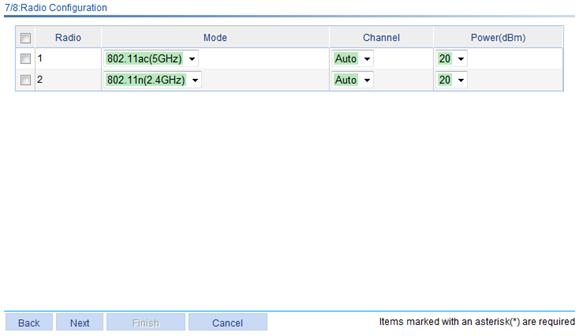
|
Item |
Description |
|
Radio Unit |
Select the radio unit for the AP. |
|
Mode |
Select the radio mode. |
|
Channel |
Select the channel to be used. Auto—Specifies the automatic channel mode. With Auto specified, the AP evaluates the quality of channels in the wireless network, and selects the best channel as the working channel. After the channel is changed, the power list is refreshed. |
|
Power |
Select the transmission power. The maximum power of the radio depends on the country code, working channel, AP model, radio mode, and antenna type. If 802.11n is specified as the radio mode, the maximum power of the radio also depends on the bandwidth mode. |
|
Select a radio unit and bind the wireless service specified in "Wireless configuration" to the specified radio unit. NOTE: Set appropriate radio mode, working channel, and power as needed for a radio unit. These settings take effect only after you bind the wireless service to the specified radio unit. |
|
Configuration summary
1. On the radio configuration page, click Next to enter the configuration summary page.
The configuration summary page displays configurations you have made.
2. Click finish to save your configurations.
Quick Start configuration examples
The wireless access methods that can be configured through the Quick Start wizard include simple text authentication, WEP (Open-System) encryption, and WPA-PSK and WPA2-PSK authentication. To configure other wireless access methods, for example, MAC address authentication and remote 802.1X authentication, select Wireless Service > Access Service from the navigation tree and perform configuration on the relevant page. For more information, see the configuration examples in "Configuring wireless service."
Simple text authentication configuration example
Network requirements
As shown in Figure 9, deploy an AP to enable the client to access the internal network resources at any time. The following requirements must be satisfied:
· The AP provides a plain-text wireless service with SSID service.
· 802.11n (2.4 GHz) is adopted to work with the existing 802.11g network and meet the high bandwidth requirement.

Configuring the AP
1. Perform basic configurations:
a. From the navigation tree, select Quick Start.
The home page of the Quick Start wizard appears.
b. Configure time parameters, login password, and login IP address as needed.
2. Configure wireless service:
a. On the IP configuration page, click Next.
The wireless configuration page appears.
b. Use default setting for Primary Service Authentication type, specify the SSID as service, and use default setting for Encrypt (no encryption is performed).
Figure 10 Wireless configuration page
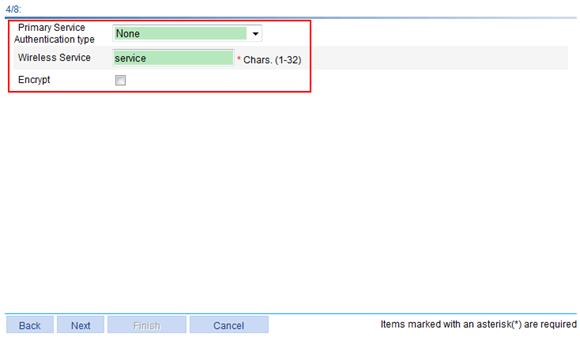
c. Click Next.
The radio configuration page appears.
d. Select the 802.11n(2.4GHz) box, and bind wireless service service to the 802.11n (2.4 GHz) radio, and use default settings for other parameters.
e. Click Next.
Figure 11 Radio configuration page

3. Check and apply the configurations:
Click Next to enter the configuration summary page.
If you want to modify certain configurations, click Back to return to the previous pages; if the configurations are correct, click finish to apply the configurations.
Verifying the configuration
1. Launch the wireless client, and refresh the network list.
2. Select the configured service in Choose a wireless network (service in this example), and click Connect.
The client can access the WLAN network after being associated with the AP.
You can view the online clients on the page you enter by selecting Summary > Client from the navigation tree.
WEP (Open-System) encryption configuration example
Network requirements
In a small office as shown in Figure 12, perform WEP (Open-System) encryption configuration on the AP. The following requirements must be satisfied:
· The AP provides a WEP (Open-System) encryption wireless service with SSID wep.
· 802.11n (2.4 GHz) is adopted to inter-work with the existing 802.11g network and meet the high bandwidth requirement.

Configuring the AP
1. Perform basic configurations:
a. From the navigation tree, select Quick Start.
The home page of the Quick Start wizard appears.
b. Configure time parameters, login password, and login IP address as needed.
2. Configure wireless service:
a. On the IP configuration page, click Next.
The wireless configuration page appears.
b. Use default setting for Primary Service Authentication type, specify the SSID as wep, and select the Encrypt box.
Figure 13 Wireless configuration page
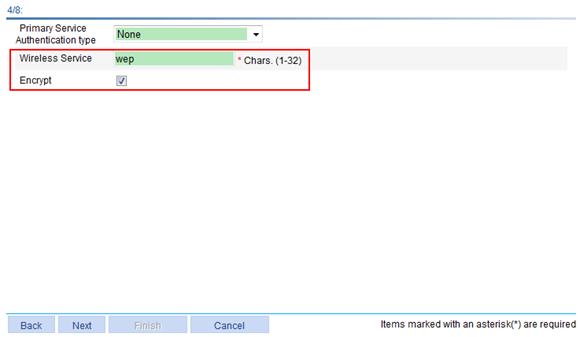
c. Click Next.
The encryption configuration page appears.
d. Select WEP40 for Encryption Mode, 1 for Key ID, and 5 Alphanumeric Chars for Key Length, and enter 12345 for WEP Key.
Figure 14 Encryption configuration page
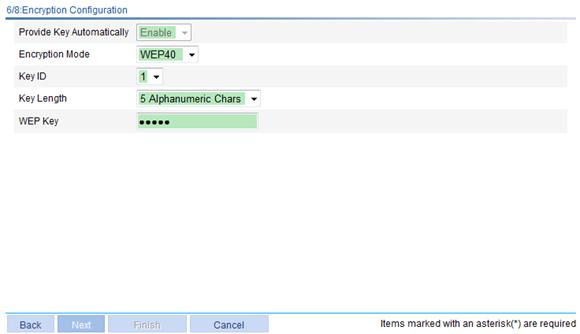
e. Click Next.
The radio configuration page appears.
f. Select the 802.11n(2.4GHz) box, bind wireless service wep to the 802.11n (2.4 GHz) radio, and use default settings for other parameters.
g. Click Next.
Figure 15 Radio configuration page
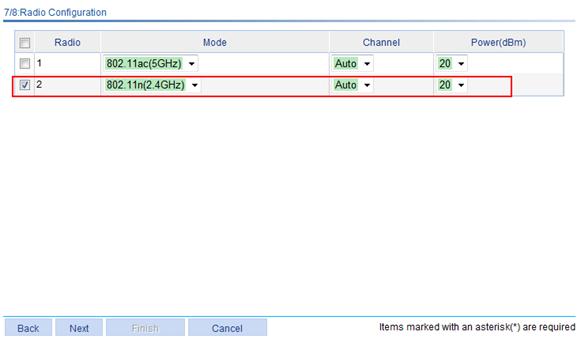
3. Check and apply the configurations:
Click Next to enter the configuration summary page.
If you want to modify certain configurations, click Back to return to the previous pages; if the configurations are correct, click finish to apply the configurations.
Verifying the configuration
1. Launch the wireless client, and refresh the network list.
2. Select the configured service in Choose a wireless network (wep in this example), and click Connect.
3. In the dialog box that appears, enter the WEP key 12345 (same as the WEP key configured on the AP).
The client can access the WLAN network after being associated with the AP.
You can view the online clients on the page you enter by selecting Summary > Client from the navigation tree.
